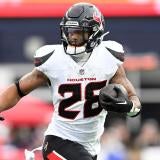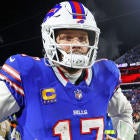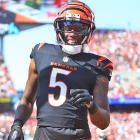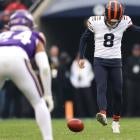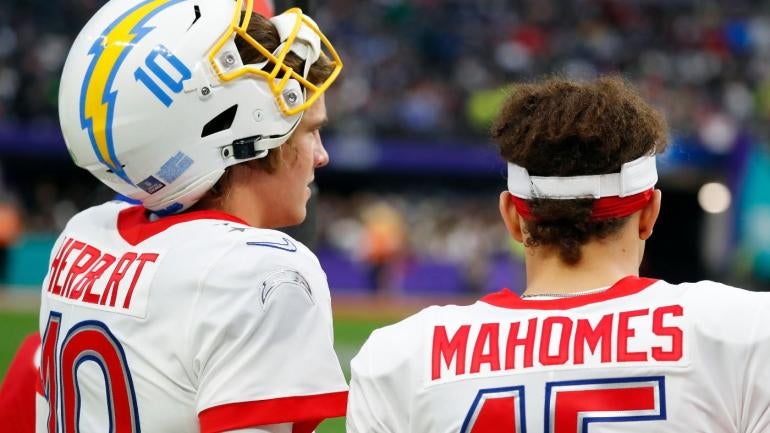
On this week's edition of "Thursday Night Football," we've got a blockbuster matchup of two of the best teams in the league -- each from what is widely expected to be the NFL's best division. Both the Kansas City Chiefs and Los Angeles Chargers began their season with victories over quality opponents, and now they get to square off in what should prove to be one of the more consequential games of the early part of this year.
The winner of this game will stake itself to an early lead in the AFC West, and thus the race for one of the top seeds in the conference. These two teams played a couple of thrillers a year ago, with the Chargers prevailing in the early-season matchup thanks to aggressive decision-making and big plays, and the Chiefs coming out on top in an overtime contest late in the year.
Which squad will get itself off to an early division lead? We'll find out soon enough. Before we break down the matchup, here's how you can watch the game.
How to watch
Date: Thursday, Sept. 15 | Time: 8:15 p.m. ET
Location: GEHA Field at Arrowhead Stadium (Kansas City, Missouri)
Streaming: Amazon Prime Video
TV: Check local market listings
Follow: CBS Sports App
Odds: Chiefs -4, O/U 54
When the Chargers have the ball
The Chargers will be without Keenan Allen for this contest, just as they were for much of their Week 1 victory over the Raiders. The Chiefs, meanwhile, will not have rookie cornerback Trent McDuffie -- who was acquitting himself quite well against the Cardinals before leaving with an injury of his own.
McDuffie's absence will leave Kansas City's primary corners at a size-and-physicality disadvantage against Justin Herbert's top remaining target, Mike Williams, who goes 6-foot-4 and 218 pounds compared with Rashad Fenton's 5-11, 188 and L'Jarius Sneed's 6-0, 189. Williams was not targeted heavily by Herbert in the Week 1 matchup, with the Los Angeles signal-caller instead spreading the ball around to all of his playmakers: Williams, Allen, Joshua Palmer, DeAndre Carter, Gerald Everett, Tre' McKitty, and Austin Ekeler all tied for the team lead with four targets apiece.
Herbert's ability to fire absolute laser beams all over the field makes this kind of distribution possible. He (like the quarterback on the other side of this matchup) is the type of rare talent who can make targets of disparate skill levels into equally dangerous threats, simply because he is able to connect on throws that should not really be possible.
Still, the size advantage Williams and, to a lesser extent, Palmer, Everett, and McKitty have over the Chiefs defensive backs should provide opportunities for Herbert to fit the ball into tight windows -- because he can (and might need to) trust them to come away with contested catches. Kansas City's coverage in Week 1 against Arizona was quite good, with top Cardinals wideout Marquise Brown averaging only 2.2 yards of separation per target, according to NFL.com's Next Gen Stats -- 13th-lowest out of 74 receivers and tight ends who were targeted five or more times. Brown had averaged 3.3 and 3.5 yards of separation over the previous two seasons, indicating that this was likely more about sticky coverage (and possibly Arizona's offensive design) than an inability to separate.
The Los Angeles offensive line held up well against a very good Raiders pass rush in Week 1. Herbert was under a decent amount of pressure, but had to scramble only once, did not take a sack and was knocked down just two times on 35 dropbacks. Kansas City's pass rush is not nearly as fearsome as is that of Las Vegas, so there should not be as many worries about Herbert having time to throw in this matchup. It's going to more about whether Steve Spagnuolo and company can figure out a way to generate pressure without having to give up too many bodies from the back end and thus making throwing lanes wider than they want them to be. Chris Jones is the best pass rusher the Chiefs have, but the Chargers are actually quite strong up the middle with the combination of Matt Feiler, Corey Linsley, and rookie Zion Johnson solidifying things in front of Herbert.
Austin Ekeler played only 49% of Los Angeles' offensive snaps in Week 1, but he was also the only Chargers back who was all that effective, with his 13 carries and four receptions gaining 72 yards compared with just 47 yards on 13 total touches for Joshua Kelley and Sony Michel. Perhaps rookie back Isaiah Spiller can be a better compliment to Ekeler when he gets on the field, but at the moment, L.A. might want to get him back into the 60-70% of snaps range -- especially in a matchup like this where they might need to score on every drive to keep pace with another of the league's most explosive offenses.

Pick Six Newsletter
Crafted By The Best NFL Experts
Get the day's big stories + fun stuff you love like mock drafts, picks and power rankings.
Thanks for signing up!
Keep an eye on your inbox.
Sorry!
There was an error processing your subscription.
When the Chiefs have the ball
After being blitzed at by far the lowest rate in the NFL last season (11.3% vs. a league average of 25.3%, with the next-closest qualified passer coming in at 20.3%), Patrick Mahomes faced five or more rushers more often than any other passer in Week 1. The Cardinals sent extra bodies on 22 of his 41 dropbacks -- a rate of 53.7%. The league average in season openers was just 23.7%, and Jalen Hurts (40.9%) and Trevor Lawrence (40%) were the only other QBs blitzed at least 40% of the time. The strategy was... not successful, as Mahomes completed 15 of 21 attempts for 137 yards and four touchdowns with zero sacks, despite being pressured on 11 of Arizona's 22 blitzes.
In the first year of the Brandon Staley era, the Chargers blitzed at an almost exactly league average rate. They hovered around that range in their two games against the Chiefs as well, sending pressure on 22% and 24% of Mahomes' dropbacks. (Mahomes went 15 of 21 for 264 yards, two touchdowns, two interceptions and one sack on those plays.) They backed off the blitz rate quite a bit in Week 1 against the Raiders, sending five or more pass rushers on just 16.3% of passing snaps.
It's perhaps worth noting that despite coming away with six sacks, the Chargers generated pressure at a below-average rate in Week 1, getting a sack, hit, or hurry on 28% of Derek Carr's dropbacks compared with a league average of 33% in season openers. That's despite boasting an elite edge rush duo of Joey Bosa and Khalil Mack, who accounted for nine of the team's 16 total pressures and 4.5 of the six takedowns. Being able to get to the quarterback without sending additional rushers is more important against Mahomes than perhaps any quarterback in the league, because he beats the blitz with absolutely deadly precision.
It's not as though sitting back in coverage is a better proposition, though. Mahomes recorded the league's highest EPA per dropback against non-blitzes in Week 1, completing 15 of 18 passes for 223 yards and a touchdown without taking a single sack. He didn't force anything at all, proving himself content to work his checkdowns and take short passes over the middle to the likes of Travis Kelce, JuJu Smith-Schuster, Marquez Valdes-Scantling, and Mecole Hardman. Smith-Schuster, in particular, was brought in specifically to attack these types of situations, and Mahomes found him in soft spots repeatedly throughout the first half.
With J.C. Jackson likely still out for the Chargers, it'll be interesting to see how Staley utilizes Derwin James as a chess piece in this matchup. He's so versatile that he can do pretty much anything. Will he man up on Kelce more often than not? Will he play in the slot to try to take away some of the Smith-Schuster stuff over the middle? If he's on Kelce, can the Chargers count on the likes of Asante Samuel Jr. -- who is very good but on the smaller side compared with Kansas City's new-look wide receiver room that has a lot of size -- and Michael Davis to match up? How much shell coverage with the safeties simply sitting over the top and forcing Mahomes to work his checkdowns all the way down the field does Los Angeles want to employ -- and will that work against an offense now designed to operate that way right up until the point that you drop a safety down so it can hit you over the top?
The Chiefs ran the ball fairly successfully in Week 1 against Arizona, with Clyde Edwards-Helaire looking better than he did at any point in his first two NFL seasons. (Both CEH and Jerick McKinnon have been able to find success behind this very good line.) The Raiders also ran the ball with a degree of success against L.A. as well, with 46.2% of their rushing attempts gaining five or more yards. The Chargers' total inability to stop the run came back to bite them quite often last year, to the point that they devoted a bunch of free-agent money this offseason to shoring up the problem. The Kansas City offensive line should still have a decent advantage in the run game here, and utilizing it a bit more often than expected could be a way to keep the Chargers pass rush off-balance.
Prediction: Chiefs 33, Chargers 30








